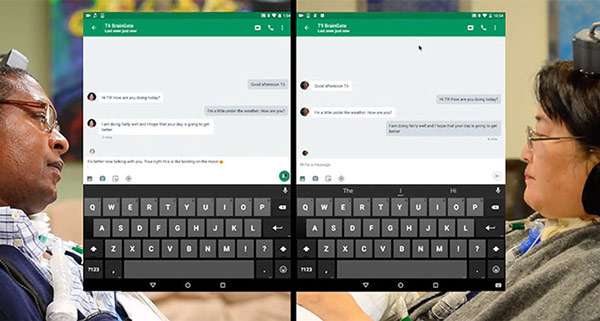The implanted brain allows the person to turn the thought into text
Participants sent messages, streamed music and browsed the web on their tablets.
Three people who were paralyzed from the neck went to the pilot program, where they could use the pilot tablet to text friends, browse the web and play music thanks to the electrode array named BrainGate2. This can have a big impact on the lives of people affected by neuropathy, injury or limb loss.

BrainGate2 can be a weapon to help bring miracles to future paralyzed people.
This system uses a series of microelectrodes implanted in the brain to decode in real time, including nerve signals related to the intention to move the limb. Three participants with an electrode grid were implanted in one part of the brain region to help control movement. This makes it possible to understand they are thinking of moving the cursor on the screen. The templates are then sent to a virtual mouse wirelessly connected to the tablet.
Using only their intentions, participants can perform a variety of popular digital tasks including web browsing and emailing. A participant requested online groceries and played a digital piano. She thinks it becomes her second 'essence'. This system even allows 2 participants to talk to each other in real time.
Of course, brain-computer connectivity technology has been studied for about a few years now. However, the highlight of BrainGate2 is that it allows users to navigate completely unmodified devices, including no special features or editing. The report says that just a few basic edits can make the system more accessible to users.

The thought content of the polio is shown on the tablet.
According to the study, participants can navigate the user interface comfortably although they do not have access to all the commonly used gestures on tablets (for example, click and drag , Multitouch…). Some of these limitations will be overcome by enabling accessibility features found in the Android operating system or 3rd party programs. In addition, modifying the operating system keyboard layout Android will also increase the ability to enter.
Basically, the findings show how the new system's communication and mobility for people with polio do not need to use special editing technologies to help them have more positive thoughts. in life.
- Finding a way to help a paralyzed person can still be grasped
- The paratrooper controls the aircraft model by thought
- Google's AI can reproduce images from text
- The new device helps people write texts by thought
- Wheelchairs controlled by thinking experiment successfully in monkeys
- The world's first silicon chip can implant into the brain and dissolve itself
- Smart home controlled by thought
- Facebook develops text typing technology by thought
- Reveal how to transform ordinary people into superman
- The keyboard is about to disappear?
- Human brain cells are successfully implanted in mice
- Can control limb paralysis by thinking
 The US company is about to build a supersonic passenger plane of 6,000km / h
The US company is about to build a supersonic passenger plane of 6,000km / h Japan develops avatar robot as in fiction film
Japan develops avatar robot as in fiction film Australia tested the world's first mango picking robot
Australia tested the world's first mango picking robot America develops technology to separate water from animal waste
America develops technology to separate water from animal waste People with good spatial memory are good at sense of smell
People with good spatial memory are good at sense of smell  This circle of purple or green: Evidence that people will never be happy
This circle of purple or green: Evidence that people will never be happy  Do not drink hot coffee when you are negotiating
Do not drink hot coffee when you are negotiating  Why should we feel guilty?
Why should we feel guilty?  NASA recruits people who lie all day, earning $ 5,000 a month
NASA recruits people who lie all day, earning $ 5,000 a month  Traditional Mediterranean meals help prevent diabetes
Traditional Mediterranean meals help prevent diabetes 